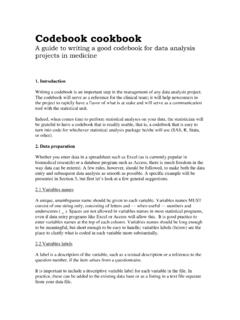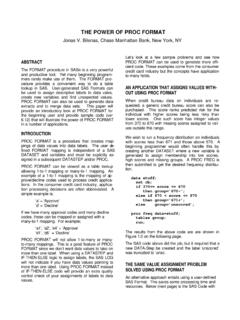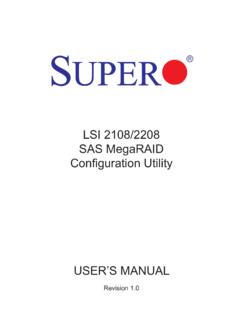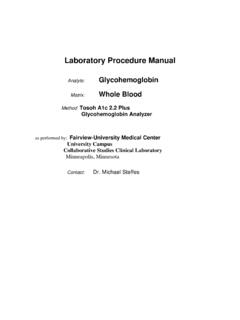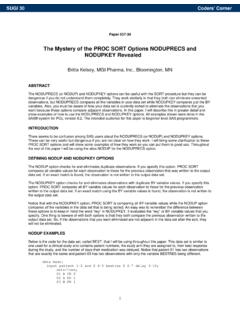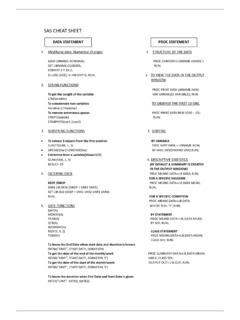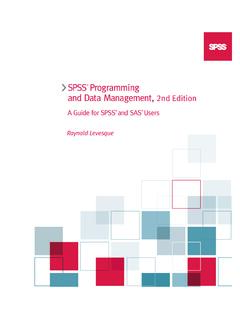Transcription of Removing Duplicates Using SAS®
1 Paper 188-2017. Removing Duplicates Using SAS . Kirk Paul Lafler, Software Intelligence Corporation, Spring Valley, California Abstract We live in a world of data small data, big data, and data in every conceivable size between small and big. In today's world data finds its way into our lives wherever we are. We talk about data, create data, read data, transmit data, receive data, and save data constantly during any given hour in a day, and we still want and need more. So, we collect even more data at work, in meetings, at home, Using our smartphones, in emails, in voice messages, sifting through financial reports, analyzing profits and losses, watching streaming videos, playing computer games, comparing sports teams and favorite players, and countless other ways. Data is growing and being collected at such astounding rates all in the hopes of being able to better understand the world around us.
2 As SAS professionals, the world of data offers many new and exciting opportunities, but also presents a frightening realization that data sources may very well contain a host of integrity issues that need to be resolved first. This presentation describes the available methods to remove duplicate observations (or rows) from data sets (or tables) based on the row's values and/or keys Using SAS . Introduction An issue found in some data sets is the presence of duplicate observations and/or duplicate keys. When found, SAS. can be used to remove any unwanted data. Note: Before Duplicates are removed, be sure to consult with your organization's data analyst or subject matter expert to see if removal is necessary or permitted. It's better to be safe than sorry. This paper illustrates three very different approaches to remove duplicate observations (or rows) from data sets (or tables) based on the observation's values and/or keys Using SAS.
3 Each example is illustrated Using a single data set, MOVIES. The Movies data set contains 26 observations, and has a structure consisting of six columns. Title, Category, Studio, and Rating are defined as character columns; and Length and Year are defined as numeric columns. The Movies data set contains two duplicate observations Brave Heart and Rocky; and two duplicate Title keys Forrest Gump and The Wizard of Oz, shown below. Page 1.. Removing Duplicates Using SAS , continued SGF 2017. Method #1 Using PROC SORT to Remove Duplicates The first method, and one that is popular with SAS professionals everywhere, uses PROC SORT to remove Duplicates . The SORT procedure supports three options for the removal of Duplicates : DUPOUT=, NODUPRECS, and NODUPKEYS. Specifying the DUPOUT= Option PROC SORT's DUPOUT= option can be used to identify duplicate observations before actually Removing them from a data set.
4 The DUPOUT= option is used with either the NODUPKEYS or NODUPRECS option to name a data set that will contain duplicate keys or duplicate observations. The DUPOUT= option is generally used when the data set is too large for visual inspection. In the next code example, the DUPOUT= and NODUPKEY options are specified. The resulting output data set contains the duplicate observations for Brave Heart, Forrest Gump, Rocky and The Wizard of Oz. PROC SORT Code PROC SORT DATA=Movies DUPOUT=Movies_Sorted_Dupout_NoDupkey NODUPKEY ;. BY Title ;. RUN ;. Resulting Table In the next example, the DUPOUT= and NODUPRECS options are specified. The resulting output data set contains the duplicate observations for Brave Heart and Rocky because these rows have identical data for all columns. PROC SORT Code PROC SORT DATA=Movies DUPOUT=Movies_Sorted_Dupout_NoDupRecs NODUPRECS.
5 BY Title ;. RUN ;. Resulting Table Page 2.. Removing Duplicates Using SAS , continued SGF 2017. Specifying the NODUPRECS (or NODUP) Option PROC SORT's NODUPRECS (or NODUPREC) (or NODUP) option identifies observations with identical values for all columns are removed from the output data set. The resulting output data saw the removal of the duplicate observations for Brave Heart and Rocky because they have identical data for all columns. PROC SORT Code PROC SORT DATA=Movies OUT=Movies_Sorted_without_DupRecs NODUPRECS ;. BY Title ;. RUN ;. Resulting Table The NODUPKEYS (or NODUPKEY) Option By specifying the NODUPKEYS (or NODUPKEY) option with PROC SORT, observations with duplicate keys are automatically removed from the output data set. The resulting output data set saw the removal of all the duplicate observations for Brave Heart, Forrest Gump, Rocky and The Wizard of Oz because they have duplicate keys data for the column, Title.
6 PROC SORT Code PROC SORT DATA=Movies OUT=Movies_Sorted_without_DupKey NODUPKEYS ;. BY Title ;. RUN ;. Page 3.. Removing Duplicates Using SAS , continued SGF 2017. Resulting Table Note: Although the removal of Duplicates Using PROC SORT is popular with many SAS users, an element of care should be given to Using this method when processing big data sets. Because sort operations are time consuming and CPU- intensive operations, requiring as much as three times the amount of space to sort a data set, excessive demand is placed on system resources. Instead, SAS professionals may want to consider Using PROC SUMMARY with the CLASS. statement to avoid the need for sorting altogether, see Method #2. Method #2 Using PROC SQL to Remove Duplicates The second method of Removing Duplicates uses PROC SQL. PROC SQL provides SAS users with an alternative to Using PROC SORT, a particularly effective alternative for RDBMS users and SQL-centric organizations.
7 Two approaches to Removing Duplicates will be illustrated, both Using the DISTINCT keyword in a SELECT clause. Specifying the DISTINCT Keyword Using PROC SQL and the DISTINCT keyword provides SAS users with an effective way to remove duplicate rows where all the columns contain identical values. The following example removes duplicate rows Using the DISTINCT keyword. Removing duplicate Rows Using PROC SQL. proc sql ;. create table Movies_without_DupRows as select DISTINCT (Title), Length, Category, Year, Studio, Rating from Movies_with_Dups order by Title ;. quit ;. Page 4.. Removing Duplicates Using SAS , continued SGF 2017. Resulting Table Specifying the DISTINCT Keyword, GROUP BY, HAVING-Clauses Using the DISTINCT keyword, a GROUP BY-clause and HAVING-clause, rows with duplicate keys can be removed from an output table. The resulting output data set see the removal of all duplicate observations: Brave Heart, Forrest Gump, Rocky and The Wizard of Oz because they have duplicate keys data for the column, Title.
8 PROC SQL Code proc sql ;. create table as select DISTINCT(Title), Length, Category, Year, Studio, Rating from group by Title having Title = MAX(Title). AND Length = MAX(Length). AND Category = MAX(Category). AND Year = MAX(Year). AND Studio = MAX(Studio). AND Rating = MAX(Rating) ;. quit;. Page 5.. Removing Duplicates Using SAS , continued SGF 2017. Resulting Table Method #3 Using PROC SUMMARY to Remove Duplicates The third method of Removing Duplicates uses PROC SUMMARY with the CLASS statement. Using PROC SUMMARY. with the CLASS statement provides SAS professionals with a more efficient alternative than PROC SORT, and other methods, by avoiding the need for sorting in advance. Without the sorting requirement, considerably less system resources are needed to identify Duplicates . But three additional aspects make this method an effective alternative: the specification of the NWAY parameter that corresponds to the combination of all CLASS variables, the specification of a CLASS statement to collapse observations with the same column values, and the creation of a _FREQ_ column containing the number of occurrences.
9 In the next example, a CLASS statement with all the variables is specified to select observations (rows) with multiple occurrences ( Duplicates ) in the entire record (observation). The OUTPUT. OUT= parameter renders the results to an output SAS data set. Removing Rows with duplicate Variable Values Using PROC SUMMARY. proc summary data=Movies_with_Dups nway ;. class Title Length Category Year Studio Rating ;. id Length Category Year Studio Rating ;. output out=Movies_Summary_without_DupRecs (drop=_type_) ;. run ;. proc print data=Movies_Summary_without_DupRecs (rename=(_freq_ = Dupkey)). noobs ;. run ;. Page 6.. Removing Duplicates Using SAS , continued SGF 2017. Resulting Table In the next example, a CLASS statement with the key variable is specified to select observations with multiple occurrences ( Duplicates ) just in the key itself. The OUTPUT OUT= parameter renders the results to an output SAS data set.
10 Removing Rows with duplicate Keys Using PROC SUMMARY. proc summary data=Movies_with_Dups nway ;. class Title ;. id Length Category Year Studio Rating ;. output out=Movies_Summary_without_DupKey (drop=_type_) ;. run ;. proc print data=Movies_Summary_without_DupKey (rename=(_freq_ = Dupkey)). noobs ;. run ;. Page 7.. Removing Duplicates Using SAS , continued SGF 2017. Resulting Table Conclusion While many users use PROC SORT to remove duplicate observations (or rows) based on the key and/or the entire record from SAS. data sets, two other approaches were shown. Since sorts can be expensive and time-consuming processes, it's advisable to use approaches that reduce the utilization of system resources to remove Duplicates , such as with PROC SQL or PROC SUMMARY. A. second approach to Removing Duplicates Using PROC SQL was shown, because much of today's data resides in databases and a definite need to be able to use a universal language to remove Duplicates exists.










